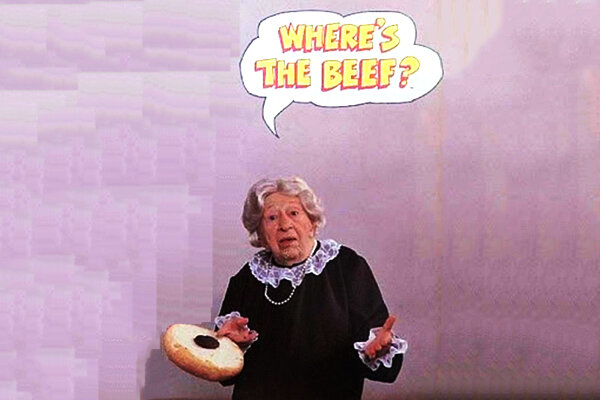The “Where’s the Beef?” campaign, launched in 1984, transcends mere advertising genius. It’s a cultural touchstone, reflecting society’s yearning for authenticity and influencing the fast-food landscape. Let’s delve into how Wendy’s captured hearts and transformed the industry through compelling storytelling.
Crafting a Memorable Campaign
In 1984, Wendy’s, a relatively small player in the fast-food burger market, was struggling to compete with bigger giants like McDonald’s and Burger King. These competitors dominated with their signature oversized burgers, the Big Mac and Whopper, focusing on size and spectacle. Wendy’s, however, offered a simpler, “single” patty burger with a focus on quality.
Their strategy? Emphasize quality and authenticity, setting them apart from competitors vying for bigger burgers. This differentiation laid the foundation for an epic advertising win.
Emotional Resonance
Wendy’s tapped into the collective consumer frustration with empty promises. The “Where’s the Beef?” phrase perfectly encapsulated this yearning for real value in a skeptical era. It wasn’t just about hamburgers; it was a demand for honesty and substance in a world of exaggeration.
The “Where’s the Beef?” campaign, spearheaded by advertising legend Joe Sedelmaier, was a masterclass in unconventional marketing. It directly addressed the issue of perceived disparity between the large bun size and small patty in competitor burgers.
The “Where’s the Beef?” Commercial
Clara Peller, an ordinary woman, became the campaign’s face. Her simple question, “Where’s the Beef?”, resonated with consumers tired of feeling cheated. Peller transcended her role; she embodied everyone who sought genuine value beyond the hype.
The campaign was launched in January 1984 with a series of television commercials featuring Clara Peller. The phrase “Where’s the Beef?” quickly became a cultural phenomenon, spreading beyond the commercials to T-shirts, bumper stickers, and even political discourse.
Catchphrase Symbolism
The phrase’s simplicity was its power. It highlighted the gap between promised and delivered value. This linguistic choice went beyond burgers; it was a universal cry for truth in a world of inflated claims.
- Simple, catchy slogan: “Where’s the beef?” resonated with consumers due to its directness and humor. It questioned the substance behind competitors’ flashy offerings and subtly poked fun at their marketing tactics.
- Real people, genuine emotions: The commercials featured ordinary-looking people, not models, reacting with confusion and disappointment to the lack of beef in their burgers. This authenticity struck a chord with viewers, feeling more relatable than polished marketing messages.
- Clever use of repetition: The phrase “Where’s the beef?” was repeated throughout the commercials and in print ads, solidifying it in the public consciousness.
- Focus on product quality: Beyond the humor, the campaign subtly shifted the focus to Wendy’s superior beef quality and larger patty offerings.
Creating Cultural Impact
The campaign mirrored the 1980s zeitgeist: a yearning for authenticity and skepticism towards exaggeration. “Where’s the Beef?” transcended fast food, becoming a cultural symbol of the era’s collective demand for integrity.
The Power of Storytelling
This campaign’s success wasn’t limited to a catchy phrase. The narrative around it created a profound emotional connection. Relatable characters and situations made audiences empathize with the quest for more than what meets the eye. Peller wasn’t just a character; she was a symbol of truth-seeking.
Results of the campaign
“Where’s the Beef?” stands as a testament to the enduring power of engaging storytelling. Wendy’s triumphed not by chance, but by understanding their audience’s pulse. The emotional resonance of the campaign and its relatability were the driving forces behind its monumental success.
Financial Impact:
- 31% Revenue increase: This is a significant and undeniable success, demonstrating the campaign’s effectiveness in driving sales.
- Increased brand awareness: This solidified Wendy’s position within the market and opened doors to new customer segments.
Cultural Impact:
- Catchphrase & Merchandise: The phrase’s cultural penetration was immense, solidifying its place in the zeitgeist and generating additional revenue through merchandise.
- Viral marketing: The campaign tapped into the power of early viral marketing, spreading organically and increasing reach.
- 1984 presidential campaign: The phrase’s influence reached beyond fast food, even impacting the political landscape.
- 2023 revival: The enduring impact is evident in the recent revival, showing the campaign’s continued relevance and nostalgia factor.
Unique Aspects:
- Casting choice: Featuring everyday people added authenticity and resonated with audiences tired of unrealistic portrayals.
Overall, the “Where’s the Beef?” campaign was a multi-faceted success story. It delivered significant financial results, solidified Wendy’s brand identity, and resonated culturally, leaving a lasting legacy that continues to be relevant even today.
Wrapping Up
This iconic phrase reminds us that storytelling remains an essential tool for creating not only compelling content but also fostering lasting customer connections. The “Where’s the Beef?” campaign’s enduring legacy serves as a reminder of the power of narratives in increasing sales and fostering unwavering brand loyalty.
“Where’s the beef?” remains one of the most iconic marketing campaigns of all time. It’s a testament to the power of creativity, humor, and understanding your audience. It forever changed the fast-food landscape and demonstrated the importance of focusing on substance over spectacle.
Also Read: A Case Study on Budweiser: “Wassup?” Brand Campaign
To read more content like this, subscribe to our newsletter
Go to the full page to view and submit the form.


